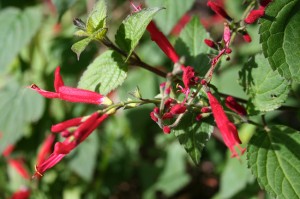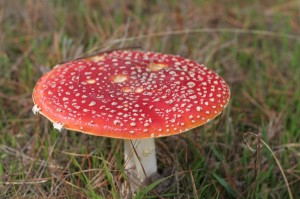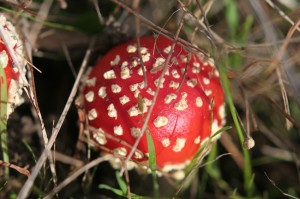At this time of year articles begin to proliferate describing plants you can grow that will lend splashes of colour to sombre autumn and winter days. As usual I am gaining much pleasure from the bright red flowers of pineapple sage (Salvia elegans). So too are the eastern spinebills who flash their tawny throats at me as they fossick for nectar. Also dog’s bane (so named because it’s ability to repel some dogs), Plectranthus ornatus, has been sporting its strong, mauve flowers for months now and will continue to do so right through winter. Really for me the colour highlights in late autumn and winter come from all the plants I haven’t planted, the ones that turn up whether you want them or not.
I love the vibrant greens of the mosses — soft carpets sparkling with drops of early morning dew. I cringe every time a caller on a talk back show asks how to get rid of moss from the lawn or a path. Not only are they green jewels in a winter garden, they are also a sign that that garden is healthy. Other favourites are the pale green lichens growing on the branches of old trees (they don’t actually damage the trees), and the bright yellow lichen that covers the bark on the south side of some Eucalypts.
Really though it is the fungi that appear at this time of year that hold the greatest fascination for me. I wish I knew more about these secretive plants. Most media concentration seems to be on the edible forms, but closer inspection also reveals their often surreal beauty and the interesting role they play as part of the ecosystem of the garden.
Last year we had the shaggy ink-caps coming up in the naturestrips, their speckled brown and white umbrellas almost irresistible to football kicking young boys. Under pain of death they lasted for more than a week before they became a new puppy’s plaything. Further afield were small, purple, flat-topped toadstools, only midgets beside the dinner-plate sized ones with chocolate brown tops and orange pores underneath. Then there were the bracket fungi, brown, red, bright orange, yellow growing on trees and timber garden edges. And those wonderful toadstools so beloved by storytellers, mentioned in myths and legends, the makers of fairy rings — the fly agaric (Amanita muscaria). These toadstools are bright red with white spots and gained their uninspiring common name from Northern Europeans who soaked them in milk to kill flies.
While contemplating these sometimes bizarre bits of nature it is worth remembering that the toadstool we see above the ground is only the fruiting body of the fungus. Most of the fungus is below the ground in the form of a spiderweb-like network of threads, known as the mycelium. This mycelium, by feeding on dead plant material, plays an essential role in the decomposition of organic matter in the soil.
If, like me, you are a gardener who likes the spontaneity of self-sown plants that pop up in odd corners, don’t forget to also look for those garden freeloaders, the mosses, lichen and fungi, that arrive from who knows where, to add yet another dimension to the enjoyment of your garden. — PW



